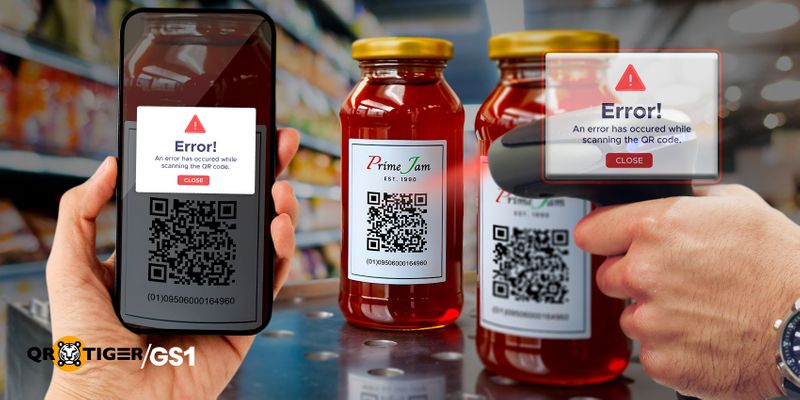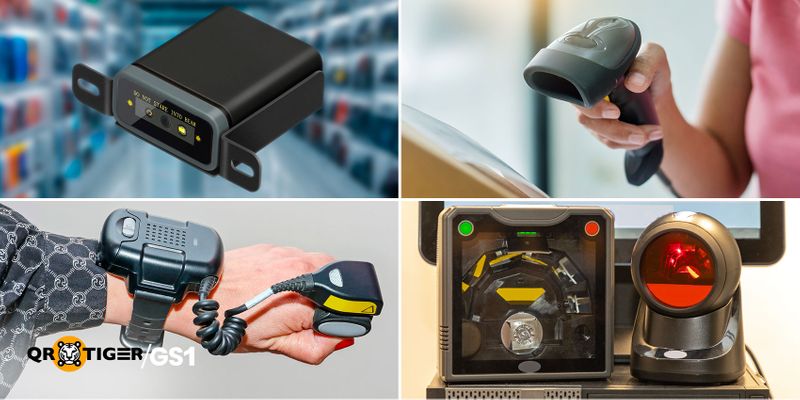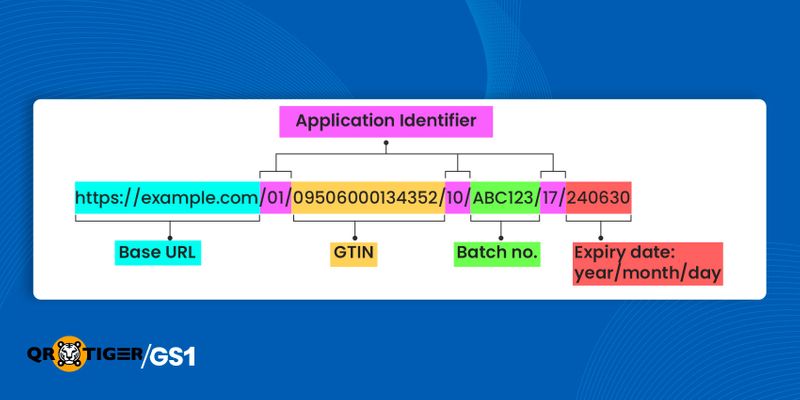Why is My GS1 QR Code Not Working?

GS1 Digital Link QR codes will be widely used in retail and logistics to encode product information in a standardized format in future years. However, sometimes, they fail to scan or decode properly on barcode scanners or smartphone apps. Here are the most common reasons for your GS1 QR code not working.
Physical or Visual Issues (Image-related)
These are issues tied to how the QR code is printed, displayed, or visually handled. If the scanner can't "see" it properly, it won't scan, no matter how perfect the data inside is.
Low-resolution printing (e.g., fuzzy bitmap edges): If the image was stretched or printed from a blurry file, modules(small dots or squares) blend into each other. Avoid using low DPI assets or screenshot-based copies.
Low contrast: Scanners struggle with GS1 QR code colors that don’t provide enough visual separation. Avoid placing the code on dark or textured backgrounds. To ensure reliable scanning, it's best to use a dark foreground on a light background, ideally black on white.
Too small (below 16 mm edge to edge, including quiet zone): If the QR code is physically too small, especially on product labels or shrink films, the scanner can’t resolve the modules (the tiny squares).
Quiet zone missing or too tight: The blank space around the QR code (at least 4 modules wide) is critical. The scanner doesn’t know where the code begins or ends without it.
Warping on curved surfaces: Cylindrical bottles and flexible packaging can distort the shape, making it unreadable. The modules appear stretched or compressed.
Scratches, smudges, or packaging distortions: Damage during production or handling can break the pattern. Even minor scratches or folds can disrupt scanning.
Overlays like shrink wrap, tape, varnish, or glare: Glossy finishes and plastic layers cause reflection. That light bounce messes up the scanner’s ability to detect contrast.
Heavy pattern customization or adding image overlays: Branding the QR with logos or designs inside the pattern looks good, but often sacrifices readability. Some scanners give up entirely.
Using shades of red and orange in the foreground: Most barcode scanners use red LEDs. Under that light, red-on-white codes disappear, making them invisible to the sensor.
Inverted colors (light QR on dark background): Works on some apps, but many phone cameras and legacy scanners expect dark-on-light. Reversing that throws them off.
Incorrect aspect ratio (QR stretched or compressed): Sometimes, the QR becomes rectangular during layout or resizing. A QR code must be square. Any warping, even by 2–3%, throws off decoding.
Color bleed or ink spread: When it comes to GS1 QR code printing, color bleed or ink spread can happen, especially with thermal printers or poor inkjet setups. The black squares slightly expand or blur into each other, rounding off sharp corners. That tiny detail can cause a failed result.
Outdated or Incompatible Scanner Hardware

These issues come from the scanner itself, whether it's not capable, not configured, or just not meant for the job. It doesn't matter if your QR is perfect; if the tool reading it can’t understand what it's seeing, it fails silently or shows a false "scan error."
1D vs. 2D Scanners: Traditional laser barcode scanners (1D) cannot read QR codes (2D). Supply chain operations require 2D imagers or multi-symbology scanners.
Low-Quality Camera (Phone Apps): Older smartphones or those with low-resolution cameras and poor autofocus capabilities may struggle to read QR codes effectively.
Dirty Scanner Lens: A smudged or dirty camera lens on a phone or dedicated scanner can significantly impair its ability to capture a clear image.
Outdated Scanner Software/Firmware: Both dedicated scanners and phone apps need up-to-date software to correctly interpret GS1 Digital Link standards and efficiently scan QR codes.
App Permissions (Phone Apps): A phone app might not have the necessary camera permissions enabled, preventing it from scanning.
Too Many Background Apps (Phone Apps): On a smartphone, too many apps running in the background can slow down the device and interfere with the scanning app's performance.
Device Compatibility Issues: Specific scanner models or phone operating systems might have known compatibility issues with certain QR code types or scanning methodologies.
Network Connectivity (for Digital Link Resolution): While the QR code itself is scanned locally, resolving the GS1 Digital Link URI requires internet access to connect to the "resolver" and retrieve the linked information. If there's no network connection (or a poor one), the digital link functionality will fail.
Syntax, Encoding, and Link Behavior Issues (Technical + Backend)

This group covers errors in the actual data, from how the QR was encoded to where it redirects.
The QR might be scannable visually, and the scanner might work fine, but the result still fails because the structure, format, or link behavior is broken underneath.
GTIN is not in 14-digit format: If you're encoding a GTIN with fewer than 14 digits, it must be left-padded with leading zeros to make up the missing digits.
Example: GTIN-13 1234567890123 → 01234567890123
Incorrect URL structure or wrong AI syntax: GS1 Digital Link uses path segments, not query strings or equals signs.
❌ Wrong: /gtin=1234567890123
✅ Correct: /01/01234567890123
Missing or duplicated AIs: Using the same GS1 Application Identifier more than once in the same link, or skipping required AIs (like /01/GTIN), will break interpretation.
Some scanners will ignore the code entirely if they see syntax conflicts. Check the complete GS1 Application Idetifier list to ensure proper formatting.
Unsupported or unencoded characters in the URI: Special characters like &, %, #, or even spaces must be properly encoded.
Some scanners or apps may truncate the link or reject it if they're not.
Using text-mode QR encoding instead of structured URI: If the QR was generated without proper Digital Link formatting (e.g., pasted raw into a text-mode generator), it becomes just a block of data, not a GS1-readable URI.
Faulty URL shortening or redirect tools: If you’re using custom redirects or shorteners, any glitch, like extra slashes, double encoding, or session tokens, can break the path or make it unresolvable.
Link leads to a dead or unresolved domain: If the QR points to a domain that doesn’t exist, was mis-typed, or got taken down, the scan fails post-decode.
Too many chained redirects: Most scanners and apps tolerate only 2–3 redirects.
Any more than that, and the process stalls or times out.
Expired or misconfigured HTTPS certificate: If the final URL uses HTTPS but has an invalid or expired certificate, many scanners will block it automatically.
Internet access is required but unavailable: The scan will fail if the scanner or app is expected to follow the link and load something, but cannot connect.
Redirect points to a geo-restricted or blocked domain: Some warehouse networks block unknown or external URLs.
The link will never load if the final destination is behind a firewall, country block, or content filter.
Expired Dynamic QR Code Campaigns: Some dynamic QR code platforms have scan limits or expiration dates for campaigns. If the subscription or campaign expires, the QR code will no longer function..
Authentication Barriers: QR links pointing to pages that require login or token-based access.
Some companies embed links to internal systems, like ERPs or PLMs, which return a 403 or login screen when scanned externally.
Slow webpage loading or heavy destination content: Even if the QR resolves correctly, if the landing page is too large, unoptimized, or filled with scripts, it may take too long to load, especially on slower warehouse Wi-Fi or budget devices.
Some scanner apps or browsers time out if a page takes too long to respond, which gives the impression that the scan failed.
Environmental Factors
These real-world conditions mess with scanning things that have nothing to do with the code itself or the scanner's internal logic, but still cause failed reads.
Poor lighting: Scanners, especially camera-based ones, need enough light to detect the contrast in the QR pattern. Dim warehouse corners, backroom shelves, or low-lit assembly lines are all common culprits.
Direct sunlight or glare: Harsh light, especially from overhead LEDs or sunlight through a window, can wash out the image. Reflective surfaces on labels make it worse; the QR ends up looking "white on white."
Shadows or uneven lighting: If shadows fall across part of the QR code, the result can be inconsistent, especially when using mobile scanners. A clean code under bad light is still a scanning failure.
Obstructions: dirt, dust, or moisture: QR codes exposed to handling, shipping, or outdoor environments can accumulate grime, water droplets, or residue. Even a little speck in the wrong module can make a difference.
Motion blur or shaky hands: The image can blur if the item is moving on a conveyor or if someone scans it mid-swing. Many low-end devices don’t compensate well for motion. As a result, you get either nothing or, worse, a partial read.
Fixing a Non-Scanning GS1 QR Code Starts with Knowing Where to Look
A GS1 QR code that doesn’t scan isn’t always broken, but something in the chain is. It could be as simple as a bad print or as hidden as a misconfigured scanner or an expired redirect.
You can troubleshoot faster and avoid the guesswork by breaking the issue into physical, device-related, syntax-level, or environmental categories. Whether you're packaging printing, configuring warehouse systems, or deploying Digital Link campaigns, small errors can cause big failures.
Scan tests during pre-production, validating redirects, and keeping your scanner software up to date can save you a ton of backtracking later.
Still wondering about the reasons for your GS1 QR Code not working?
Test it with multiple devices, including supply chain scanners and mobile phones, and check both the visual and technical aspects. It’s usually not one big problem; it’s one small thing nobody noticed.
FAQ
Can I use a standard QR code generator for GS1 Digital Link QR codes?
GS1 Digital Link requires strict formatting (e.g., structured URIs with Application Identifiers like /01/ for GTINs). Generic QR generators may not comply with GS1 standards, leading to unscannable or misinterpreted codes. Use a GS1-certified tool for compliance.Can I reuse a GTIN from a barcode in a GS1 Digital Link QR code?
Yes, but ensure the GTIN is formatted correctly (14-digit, left-padded with zeros) and embedded in the Digital Link URI structure
UPC: 234567830123 = 00234567890123 = https://id.brand.com/01/00234567890123
Do GS1 QR codes work offline?
Partially, these codes can work offline for ERP or POS systems that read the encoded data directly. However, the web link or online content won’t load without an internet connection.




